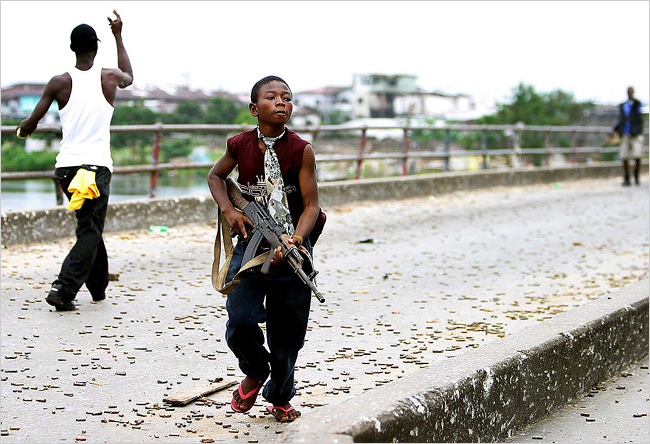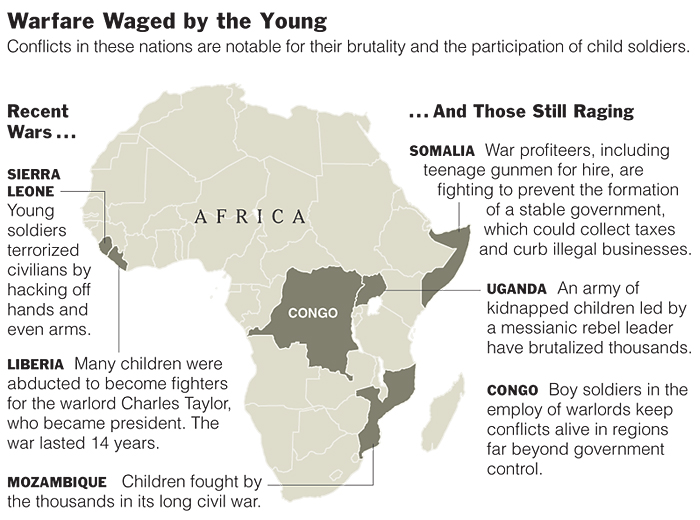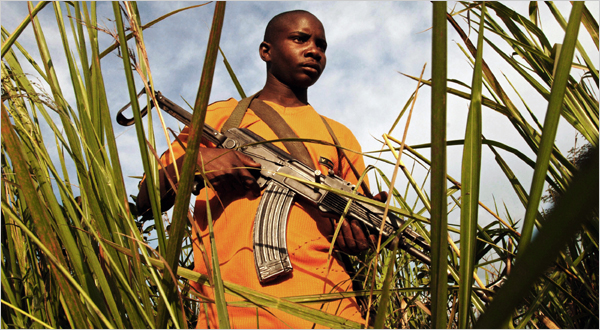| Want to send this page or a link to a friend? Click on mail at the top of this window. |
| Posted April 30, 2007 |
The Perfect Weapon for the Meanest Wars |
|
 |
|
Nic Bothma/European Pressphoto Agency |
|
| Lethal Children can be taught bloodthirsty behavior. A boy loyal to Charles Taylor, then president of Liberia, fought on a bridge littered with shell casings in 2003. |
By JEFFREY GETTLEMAN |
| NAIROBI, Kenya |
IN the early 1980s, in the lowlands of Mozambique, a new technology of warfare emerged that would sweep across Africa and soon the rest of the world: the child soldier.
Rebel commanders had constructed a four-foot tall killing machine that cut its way through village after village and nearly overran the government. Its trail was smoking huts and sawed off ears.
| The charade of idelogy is over. Children are used to fight for greed and power. |
The Mozambicans learned that children were the perfect weapon: easily manipulated, intensely loyal, fearless and, most important, in endless supply.
Today, human rights groups say, there are 300,000 child soldiers worldwide. And experts say the problem is deepening as the nature of conflict itself changes — especially in Africa.
Here, in one country after another, conflicts have morphed from idea- or cause-driven struggles to warlord-led drives whose essential goal is plunder. Because those new rebel movements are motivated and financed by crime, popular support becomes irrelevant. Those in control don’t care about hearts and minds. They see the local population as prey.
The result is that few adults want to have anything to do with them, and manipulating and abducting children becomes the best way to sustain the organized banditry.
This dynamic has fueled some of the longest-running conflicts on the continent, and it could be seen this month alone in at least three countries:
• In Somalia, within the last month, more than 1,000 people have been killed in Mogadishu, the capital, in a complex civil war compounded by warlords who command armies of teenagers. The war traces to 1991, when the central government was brought down by clans fighting over old grievances. But soon it became a contest among the warlords for control of airports, seaports and access to international aid. Sixteen years later, they are still blasting away.
• In Congo, a civil war that started a decade ago to oust the cold-war-era tyrant Mobutu Sese Seko is now a multiheaded fight in which only one of the players is the government. The rest are rebel posses fighting among themselves for a share of the timber, copper, gold, diamonds and other resources. All sides, according to a report issued this month by Human Rights Watch, rely on child soldiers.
• In Uganda, the latest in a series of peace talks — none successful so far — resumed last week, in an effort to end a reign of terror in rural areas by the Lord’s Resistance Army. That group was mustered in the late 1990s in the name of the oppressed Acholi minority, but it soon degenerated into a drugged-out street gang living in the jungle with military-grade weaponry and 13-year-old brides. Its ranks are filled with boys who have been brainwashed to burn down huts and pound newborn babies to death in wooden mortars, as if they were grinding grain.
 |
The New York Times |
Africa didn’t invent the modern under-age soldier. The Nazis drafted adolescents when they got desperate. So did Iran, which gave boys 12 to 16 years old plastic keys to heaven to hang around their necks as they cleared minefields during the Iran-Iraq War. Young teenagers have fought in religion-driven or nationalistic fights in Kosovo, the Palestinian territories and Afghanistan.
But here, in Africa, armed movements that survive on children as young as 9 have acquired a special character, nourished by breakdowns of state power or ideology. Many of these movements are about raw greed, power and brutality, with no effort to make excuses for it.
“There might have been a little rhetoric at the beginning,” said Ishmael Beah, a former child soldier in Sierra Leone and author of the best seller “A Long Way Gone: Memoirs of a Boy Soldier.” “But very quickly the ideology gets lost. And then it just becomes a bloodbath, a way for the commanders to plunder, a war of madness.”
Neil Boothby, a Columbia University professor who has worked with child soldiers across the world, said this new crop of movements lacked the features associated with the winning insurgencies of yesteryear — a charming, intelligent leader, persuasive vocabulary, the goal of taking cities.
| Magic works. Boys are taught that life and death depend on spirits. |
The typical rebel leader emerging today wants most of all to run his criminal enterprise deep in the bush. “These are brutally thuggy people who don’t want to rule politically and have no strategy for winning a war,” Dr. Boothby said.
This is a sharp change from the liberation movements of the 1970s and 1980s and the cause-driven conflicts that followed — for example, those in Zimbabwe or Eritrea. Even Rwanda’s 1994 genocide followed some familiar patterns: It remained a contest, however gruesome, for political power between two ethnic groups. And children, by and large, were the victims of atrocities by adults, rather than the other way around.
William Reno, a political scientist at Northwestern University who studies armed movements, said: “If you look back 30 years at how wars were fought in Africa, they were liberation movements — freeing their countries from apartheid or colonial rule. They had to plug into Soviet aid or American aid, and the superpowers wanted to see a state, a vision of the future.”
“The people who ended up doing well,” he said, “were the college-educated ideologues.” Their plans may have been dreamy. But at least, they had plans.
 |
Lionel Healing /Agence Francepresse - Getty Images |
| Free-For-All Militias are fighting one another in Congo. This boy's group is one. |
“We saw a lot of that in the 1980s,” said Chester Crocker, who was assistant secretary of state for Africa in the Reagan administration from 1981 to 1989. “For marketing reasons, leaders would dress themselves up in ideas.”
“Of course,” he added, “we always took it with a grain of salt.”
This charade ended with the cold war. Weak states that had been propped up by foreign aid and outside military assistance quickly collapsed. And Eastern bloc countries that had been cranking out Kalashnikovs for the Soviet Army had to find new markets. Africa, with its unpatrolled skies and endless shorelines, its gold mines and diamond mines and free-flowing cash economies, beckoned.
The result, Dr. Reno said, was that the political landscape opened up to well-armed opportunists, no longer inconvenienced by state regulations, state security or moral principles. “When there isn’t that big barrier anymore,” he said, “all these weird things start to happen.”
Like the use of child soldiers, who are often drawn into these movements, or kept there, with magic and superstition.
In many armed movements, children are taught that life and death depend on spirits, which are conjured up by their commanders and distilled in oils and amulets. Magic can spur children to do unspeakable things. It also bestows otherwise lackluster leaders with a veneer of supernatural respectability. “The commanders would wear certain pearls and said that guns wouldn’t hurt us,” Mr. Beah recalled. “And we believed it.”
Renamo, the South African-backed rebel army that terrorized Mozambique in the 1980s as it tried to destabilize the Marxist government, was among the first to turn to magic; it carved out a special role for witch doctors, whom the Marxists had marginalized.
By the time groups in Congo took that technique to its lowest depths in the late 1990s — some child soldiers there were instructed that eating their victims made them stronger — the world started paying attention. Advocates succeeded in placing the child soldier issue on the United Nations agenda and passing protocols that called for the age of combatants to be at least 18 (the United States and the United Kingdom are among the countries that have refused to sign).
But renegade armed groups continue to be a stumbling block. As lawlessness spreads, they too are spreading, from the bush to urban-area slums, where violent, quasi-religious movements seem to be taking root.
“It’s ridiculous to appeal to human rights with these groups because they are so far on the criminal end of the spectrum,” said Victoria Forbes Adam, director of the London-based Coalition to Stop the Use of Child Soldiers.
Just this month, in a shantytown near Nairobi, Kenya’s capital, enforcers from a group called the Mungiki — essentially a street gang that uses teenage muscle — hacked up several opponents in an effort to control the minibus racket. True to form, their leader has told his young henchmen that he rolled to earth in a ball of stars.
Copyright 2007 The New York Times Company. Reprinted from The New York Times, Week in Review, of Sunday, April 29, 2007.
| Wehaitians.com, the scholarly journal of democracy and human rights |
| More from wehaitians.com |